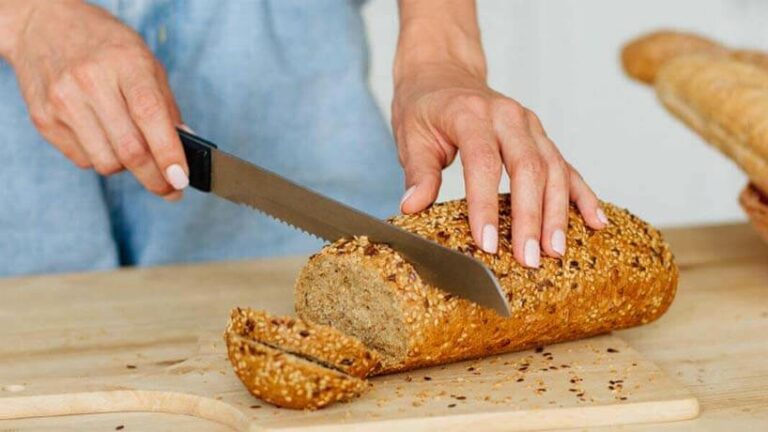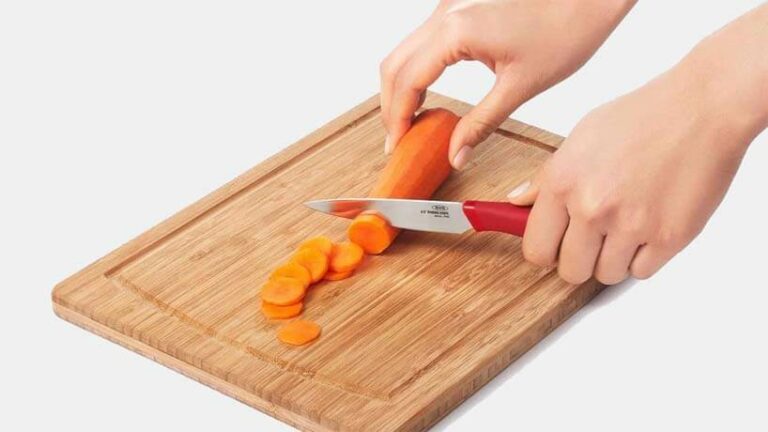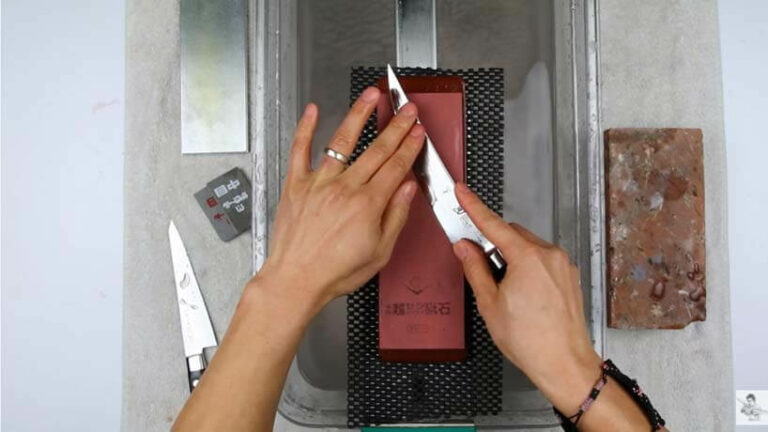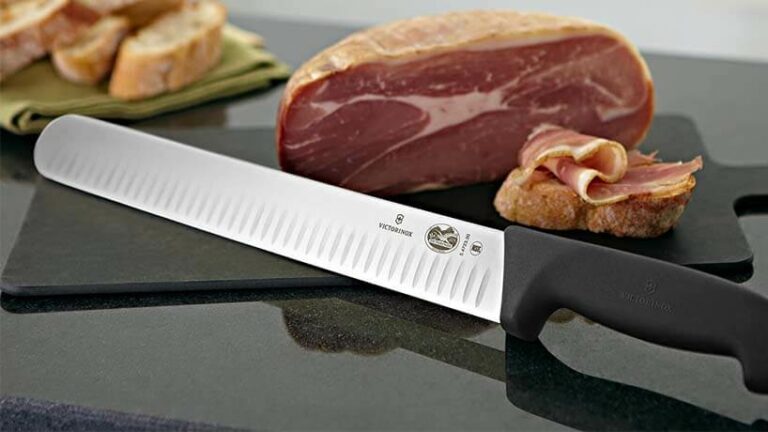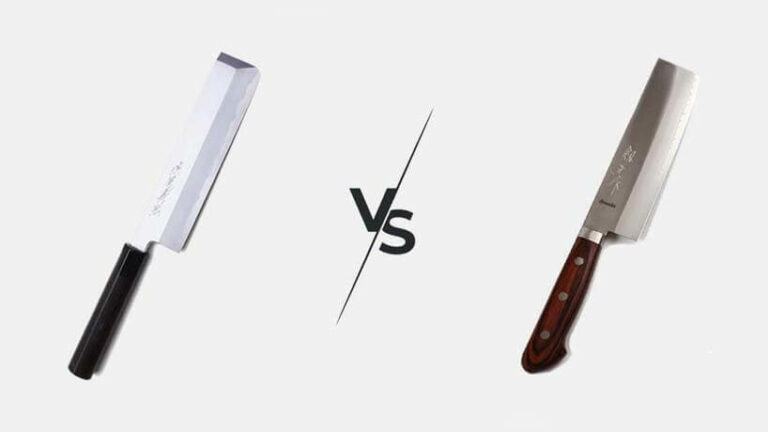Japanese culture flows throughout the world with this brilliant knife. Santoku, in itself, has become a brand and poses a significant threat to western chef’s knives. They are incredibly versatile, carrying the top-notch traits of Japanese steel and design with them. In some translations of the word, Santoku means “three primary virtues,” which in the Japanese tradition refers to mincing, slicing, and dicing.
The problem with modern-day chef’s knives is the need for one size fits all. Who wants to have one knife for chopping vegetables, one for meat, another for bones, etc.? It’s easier if we just have one knife for everything, right? Wrong! This is the main reason why knives barely last a moment and end up broken or damaged: improper use.
Knives are designed with a specific purpose in mind. If used for a different set of tasks, then the knife will give in to the abuse. Santoku knives are a prime example of this – they are not for meat and bones. So you shouldn’t think of it as a butcher knife. We’re going to show you how to cut with a santoku knife to protect the blade, ensuring that the knife lasts a long time.
What Is A Santoku Knife?
A Santoku knife is a Japanese version of the chef’s knife. Santoku blades are made from Japanese steel, usually, VG-8 or 10, which is very hard and keeps its sharpness for ages. You will seldom find a dull santoku blade.
Santoku knives have the iconic Sheepsfoot blade type, which has a downward curving spine meeting the blade edge in a rounded fashion, meaning no sharp tip on the knife. These knives are known for their thin blade design, which makes precision slicing an absolute delight.
Santoku knives come in either a double-sided bevel edge or a single-sided bevel, depending on the person. People who are looking for more accuracy when slicing would typically go for a single bevel blade edge. Most versions of this Japanese masterpiece don’t have bolsters like western chef knives. But they do have a smooth transition from the blade into the handle, which creates a comfortable grip.
This type of knife, in particular, is superbly lightweight and excellently balanced, which is one of the main reasons why professional chefs love them so much. They are smaller and shorter than a regular chef’s knife, and they come with additional convenience features like a Granton edge if that’s something that rocks your boat.
How To Use A Santoku Knife
What is a santoku knife used for, or what do you cut with a santoku knife? These are essential things to consider and take note of, especially if you’re not a trained chef. As mentioned previously, santoku blades are tough. They are made from the highest quality Japanese steel, which gives the blade fantastic edge retention and stops the blade edge from becoming dull after only a couple of uses.
The steel is also treated with heat or ice hardening processes that deliver unrivaled cutting performance in knives. The only downside to this highly effective tool is that along with the increased hardness comes a weakness of durability and toughness. The more complex the steel, the easy it is to damage it.
For that reason, we’ll have to discuss why it’s so important to know how to cut with a santoku knife. Otherwise, it could end up getting chipped or dented, which will make the knife useless. The key factors that contribute to a long-lasting knife should be applied to all knives but especially to knives meant for high performance and precision.
What Are Santoku Knives Used For?

These wondrous feats of engineering are explicitly designed for slicing, dicing, and chopping vegetables and fruit. They can be used for cutting soft meat without bones like chicken breasts but should never be used to cut hard fruits or meat with lots of bones.
These knives are brittle and will dent or chip if they come in contact with a hard surface. Santoku blades are excessively sharp, making them a formidable tool to use on thin-skinned vegetables like tomatoes. Which often get bruised when a dull blade is used to slice them.
Professional chefs love to use santoku knives because of the accuracy they get when cutting with them. When you’re serving dozens and dozens of dishes every day at a fast-paced restaurant, you don’t want to have to spend 30 minutes cutting vegetables.
If you have to spend a while doing it, you don’t want to use a dull blade that results in you hurting your wrist and feeling exhausted from cutting. Santoku knives offer quick, effortless chopping without having to throw out precision and good old fashion perfectionism. Get one, and I’ll guarantee you that cutting using a santoku knife will save you so much time and energy.
How To Hold Santoku Knives?
The way you hold a knife is essential, not just with santoku knives, but with all knives. If you’re in the kitchen a lot chopping up vegetables, you’ll know what it’s like to have a sore wrist, aching back, and tired arm muscles. It’s time-consuming and quite frustrating, to say the least.
The good news is that the way you hold the knife could hugely solve this problem and reduce the pain and pressure on your wrist and shoulders. The first thing to note is that all your fingers are not supposed to be on the handle. The handle is only for your palm and three fingers.
Place your index finger and thumb over the bolster and onto the back of the blade. Let them fold down nicely to slot into the finger grooves where the blade curves into the handle. Those curves are supports for your thumb and index fingers.
Once your first two fingers are comfortably in place, then rest your palm on the handle and wrap your other fingers loosely around the bottom of the handle. Keep your wrist in line with the handle and let the knife do the work. Use a rocking motion and use the entire length of the blade to cut through.
Final Thoughts
Unfortunately, many households nowadays only have one knife for everything and so they end up with a dull blade, using a poor knife technique and ending up in pain. A correct technique and proper care for a knife will boost the lifespan of the blade hugely.
Don’t use santoku knives on glass cutting boards or marble countertops because this will likely damage the blade. And avoid throwing them in the dishwasher. Because they’ll knock against other cutlery, maybe even damage the walls of the washer. Use the knife on the right foods and not for every single task in the kitchen.
When you slice or chop items, hold the knife properly and let the blade do the work with smooth motions. It’s best to avoid aggressive hammer action chopping, as you see in the movies. Now you know how to cut with a santoku knife, and hopefully, you’ll be delighted to slice and dice in the future.



